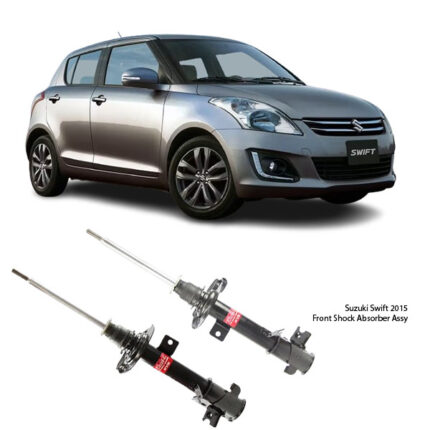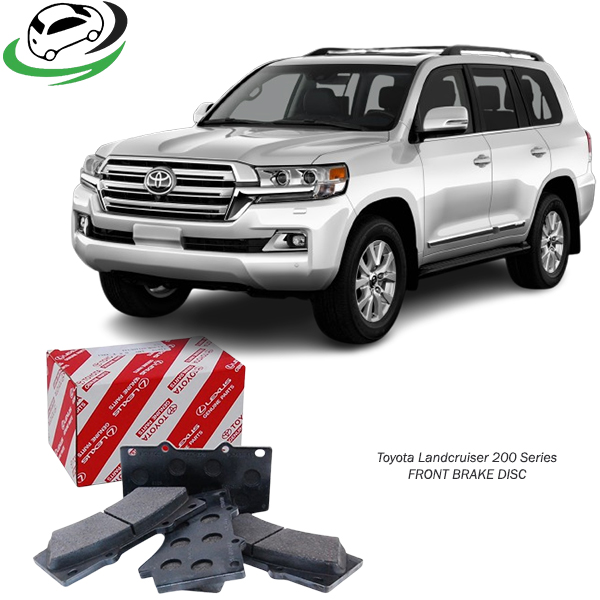Get Toyota Land Cruiser 200 Series Genuine Front Brake pads
Brake pads are a crucial component of a vehicle’s braking system, responsible for ensuring safety and efficient braking performance. Genuine front brake pads, designed specifically for a vehicle make and model, deliver superior quality and reliability. This detailed guide explores the function of genuine front brake pads, their benefits, and essential maintenance tips to ensure optimal performance and longevity.
Functions of Front Brake Pads
Front brake pads are designed to convert kinetic energy into thermal energy, enabling a vehicle to slow down or come to a complete stop. Here’s a closer look at their key functions:
- Friction Generation: When the brake pedal is pressed, the brake pads clamp onto the brake disc (rotor), generating friction. This friction is what slows the vehicle down.
- Heat Dissipation: The process of converting kinetic energy into heat can generate extremely high temperatures. Front brake pads are designed to withstand and dissipate this heat effectively, ensuring the braking system doesn’t overheat or fail.
- Even Pressure Distribution: The surface of the brake pad ensures even pressure distribution across the brake rotor, maximizing the braking force and maintaining vehicle control.
- Noise and Vibration Reduction: Modern brake pads are equipped with noise-damping features, such as shims and slots, to reduce noise, vibrations, and harshness (NVH), improving the driving experience.
Types of Brake Pads
Brake pads are categorized based on the materials used, each with unique characteristics:
- Organic Brake Pads: Made from non-metallic materials like glass, rubber, or Kevlar. They are soft and generate less noise but wear out more quickly.
- Semi-Metallic Brake Pads: Contain a mix of metal (iron, steel, and copper) and organic materials. These are durable and provide excellent heat dissipation but can be noisier and cause more wear to brake rotors.
- Ceramic Brake Pads: Made from ceramic fibers and non-ferrous materials. They offer superior performance, durability, and less noise, though they tend to be more expensive.
Benefits of Genuine Front Brake Pads
Opting for genuine brake pads provides a range of advantages that aftermarket or counterfeit parts may not offer. Here’s why choosing genuine is a smart investment:
1. Perfect Fit and Compatibility
Genuine brake pads are specifically designed for the make, model, and year of your vehicle. This ensures a perfect fit, eliminating any issues with improper installation or poor performance due to size discrepancies. The engineering precision of these parts aligns with the manufacturer’s specifications, contributing to smoother operation and longer-lasting performance.
2. Enhanced Braking Performance
Genuine front brake pads are engineered to meet or exceed original equipment manufacturer (OEM) standards. They are subjected to rigorous testing to ensure optimal friction levels, heat resistance, and stopping power. This results in consistent and predictable braking performance, especially during emergency stops.
3. Extended Lifespan
Compared to aftermarket alternatives, genuine brake pads are made from high-quality materials that are more resistant to wear and tear. This increases their lifespan, reducing the frequency of replacements and saving you money in the long run.
4. Reduced Brake Fade
Brake fade occurs when the brake pads and rotors overheat during prolonged use, reducing their ability to stop the vehicle effectively. Genuine brake pads are designed with superior heat dissipation properties, minimizing brake fade even during high-speed driving or while descending steep slopes.
5. Lower Noise and Vibration
Aftermarket brake pads may not be equipped with advanced noise-dampening features, leading to squealing, grinding, or vibrations. Genuine brake pads are designed to minimize noise and vibrations, enhancing the driving experience and ensuring quieter operation.
6. Preservation of Brake Rotors
Poor-quality brake pads can cause uneven wear on the brake rotors, leading to expensive repairs or replacements. Genuine brake pads apply even pressure on the rotors, preserving their integrity and extending their service life.
7. Manufacturer’s Warranty
Genuine parts often come with a manufacturer’s warranty, providing peace of mind. This ensures that in case of any defects or premature wear, you are covered for repairs or replacements at no extra cost.
8. Compliance with Safety Standards
Vehicle manufacturers adhere to stringent safety regulations when producing parts. Genuine brake pads meet these regulatory standards, ensuring the safety of you and your passengers. Aftermarket or counterfeit parts may not comply with the same rigorous guidelines, increasing the risk of brake failure.
Signs of Worn Brake Pads
Knowing when to replace your brake pads is essential for maintaining safe braking performance. Common signs that your brake pads are worn include:
- Squealing or Screeching Noise: High-pitched noises when braking indicate that the brake pads’ wear indicators are making contact with the rotor, signaling the need for replacement.
- Grinding Sound: A metallic grinding sound means the brake pads have worn down completely, and the metal backing plate is now rubbing against the rotor, causing damage.
- Longer Stopping Distance: If your vehicle takes longer to come to a stop, the brake pads may be worn, and replacement is necessary.
- Vibrations When Braking: If you feel vibrations or pulsations when pressing the brake pedal, the pads may be unevenly worn or the rotors warped.
- Dashboard Warning Light: Some vehicles are equipped with a brake warning light that illuminates when the brake pads are worn.
Maintenance Tips for Front Brake Pads
Proper maintenance of your brake pads will extend their lifespan and ensure that your braking system performs at its best. Here are some key maintenance tips:
1. Regular Inspections
Brake pads should be inspected regularly for signs of wear. Many manufacturers recommend checking them every 12,000 to 15,000 miles. If you frequently drive in heavy traffic, on rough terrains, or at high speeds, more frequent inspections may be necessary.
2. Timely Replacement
It’s essential to replace worn brake pads before they become too thin. Waiting too long can cause damage to the rotors and calipers, leading to more expensive repairs.
3. Brake Fluid Maintenance
Maintaining proper levels of brake fluid is essential for the overall health of the braking system. Low or contaminated brake fluid can reduce braking efficiency and lead to premature wear of the pads.
4. Rotor Resurfacing
When replacing brake pads, have the brake rotors inspected and resurfaced if necessary. Resurfacing ensures a smooth surface for the new pads to press against, reducing the risk of uneven wear.
5. Driving Habits
Your driving style significantly impacts the wear of brake pads. Avoid sudden, aggressive braking and maintain a safe following distance to minimize the frequency of hard braking.
6. Avoid Overloading
Excess weight puts additional strain on the braking system, causing the pads to wear faster. Avoid overloading your vehicle or towing heavy loads unnecessarily.
7. Use OEM Brake Pads
Always use genuine, OEM brake pads for replacements. While aftermarket parts may be cheaper upfront, they often wear out faster and may not provide the same level of performance or safety.
Conclusion
Genuine front brake pads are a vital component of your vehicle’s braking system, offering superior fit, performance, and durability. By choosing high-quality, manufacturer-approved brake pads and following proper maintenance practices, you can ensure a safer driving experience, reduce the risk of brake failure, and extend the lifespan of your braking components. Regular inspections and timely replacements are essential to avoid costly repairs and maintain optimal braking efficiency.
Follow us on Facebook for more parts.




